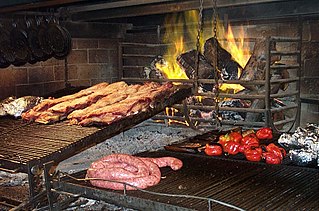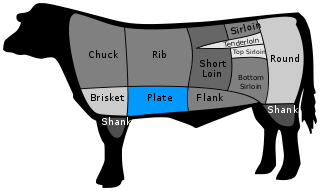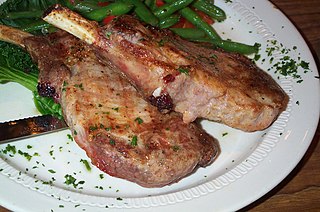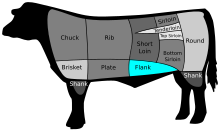
A beefsteak, often called just steak, is a flat cut of beef with parallel faces, usually cut perpendicular to the muscle fibers. In common restaurant service a single serving has a raw mass ranging from 120 to 600 grams. Beef steaks are usually grilled, pan-fried, or broiled. The more tender cuts from the loin and rib are cooked quickly, using dry heat, and served whole. Less tender cuts from the chuck or round are cooked with moist heat or are mechanically tenderized.

A fajita, in Tex-Mex cuisine, is any stripped grilled meat, optionally served with stripped peppers and onions usually served on a flour or corn tortilla. The term originally referred to skirt steak, the cut of beef first used in the dish. Popular alternatives to skirt steak include chicken and other cuts of beef, as well as vegetables instead of meat. In restaurants, the meat is usually cooked with onions and bell peppers. Popular condiments include shredded lettuce, sour cream, guacamole, salsa, pico de gallo, shredded cheese, refried beans, and diced tomatoes. "Tacos de arrachera" is applied to the northern Mexican variant of the dish.

Offal, also called variety meats, pluck or organ meats, is the internal organs of a butchered animal. The word does not refer to a particular list of edible organs, and these lists of organs vary with culture and region, but usually exclude skeletal muscle. Offal may also refer to the by-products of milled grains, such as corn or wheat.

Asado is the technique and the social event of having or attending a barbecue in various South American countries: especially Argentina, Chile, Paraguay, Peru, and Uruguay where it is also a traditional event. An asado usually consists of beef, pork, chicken, chorizo, and morcilla; all of which are cooked using an open fire or a grill, called a parrilla. Usually, red wine and side dishes such as salads accompany the main meats, which are prepared by a designated cook called the asador or parrillero.

Rodízio is an all-you-can-eat style of restaurant service in Brazilian restaurants where waiters bring a variety of grilled meats repeatedly throughout the meal, until the customer(s) signal that they have had enough.

Churrasco is the Portuguese and Spanish name for grilled beef prominent in the cuisines of Brazil, Colombia, Uruguay, and Argentina. The term is used in other Spanish- and Portuguese-speaking countries for a variety of different meat products.

The rib eye or ribeye is a boneless rib steak from the rib section.

Skirt steak is the US name for a cut of beef steak from the plate. It is long, flat, and prized for its flavor rather than tenderness. It is distinct from hanger steak (US), called skirt or onglet in Britain, a generally similar adjacent cut also from the plate.

London broil is a beef dish made by grilling marinated beef, then cutting it across the grain into thin strips. While the inclusion of "London" in the name may suggest British origins, "broil" is not a common term in UK English, and indeed the dish is American, not British.

A hanger steak (US), also known as butcher's steak, hanging tenderloin, skirt (UK), or onglet, is a cut of beef steak prized for its flavor and tenderness. This cut is taken from the plate, which is the upper belly of the animal. In the past it was among several cuts of beef sometimes known as "butcher's steak", because butchers would often keep it for themselves rather than offer it for sale. This is because the general populace believed this to be a crude cut of meat, although it is actually one of the most flavoursome.

A round steak is a beef steak from the "round", the rear leg of the cow. The round is divided into cuts including the eye (of) round, bottom round, and top round, with or without the "round" bone (femur), and may include the knuckle, depending on how the round is separated from the loin. This is a lean cut and it is moderately tough. Lack of fat and marbling makes round dry out when cooked with dry-heat cooking methods like roasting or grilling. Round steak is commonly prepared with slow moist-heat methods including braising, to tenderize the meat and maintain moisture. The cut is often sliced thin, then dried or smoked at low temperature to make jerky.

During butchering, beef is first divided into primal cuts, pieces of meat initially separated from the carcass. These are basic sections from which steaks and other subdivisions are cut. Since the animal's legs and neck muscles do the most work, they are the toughest; the meat becomes more tender as distance from hoof and horn increases.

Flap steak, or flap meat is a beef steak cut from the obliquus internus abdominis muscle of the bottom sirloin. It is generally very thin, fibrous and chewy, but flavorful, and often confused with both skirt steak and hanger steak.

Suadero, in Mexican cuisine, is a thin cut of meat from the intermediate part of the cow or pig between the belly and the leg. Suadero is noted for having a smooth texture rather than a muscle grain. Typically, suadero is confited or fried and used as a taco filling.

A meat chop is a cut of meat cut perpendicular to the spine, and usually containing a rib or riblet part of a vertebra and served as an individual portion. The most common kinds of meat chops are pork and lamb. A thin boneless chop, or one with only the rib bone, may be called a cutlet, though the difference is not always clear. The term "chop" is not usually used for beef, but a T-bone steak is essentially a loin chop, a rib steak and a rib cutlet.

A steak is a thick cut of meat generally sliced across the muscle fibers, sometimes including a bone. It is normally grilled or fried. Steak can be diced, cooked in sauce, such as in steak and kidney pie, or minced and formed into patties, such as hamburgers.

Breaded cutlet or braised cutlet is a dish made from coating a cutlet of meat with breading or batter and either frying or baking it.

Carne mechada is a stewed meat dish traditional of Spanish and Latin American cuisine. It involves slow-cooking or braising a piece of meat, often beef or pork, until it becomes tender and easy to shred.






















